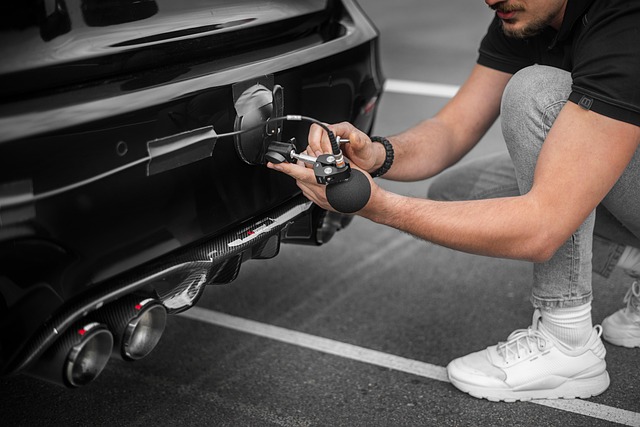Looking to register your car in California? This comprehensive guide walks you through every step, from understanding key requirements to submitting your application. Discover what documents you need, whether to visit a local DMV office or utilize online services, and how to verify your vehicle’s identity using a VIN (Vehicle Identification Number) checker. Simplify the process with these expert tips tailored for California residents.
- Understand California Car Registration Requirements
- Gather Necessary Documents for Registration
- Visit Your Local DMV Office or Use Online Services
- Verify Vehicle Identity with VIN (Vehicle Identification Number)
- Complete and Submit Your Car Registration Application
Understand California Car Registration Requirements

Before registering your car in California, it’s crucial to understand the state’s specific requirements. The California Department of Motor Vehicles (DMV) mandates several steps for car registration, including a vehicle inspection and verification of your car’s unique Vehicle Identification Number (VIN). This VIN verifier process ensures that your vehicle meets safety and environmental standards before it can be legally registered and driven on California roads.
One convenient option to complete this requirement is through mobile vin verification services. These services allow you to obtain a digital inspection right from your smartphone or tablet, eliminating the need for an in-person visit to a DMV office. A mobile VIN verifier can quickly scan your vehicle’s VIN and cross-reference it against national databases to confirm its authenticity and condition, simplifying the registration process significantly.
Gather Necessary Documents for Registration

Before you start the registration process, it’s crucial to gather all the essential documents required by the California Department of Motor Vehicles (DMV). This includes your vehicle’s registration certificate from the previous state, proof of insurance, and a valid driver’s license. Additionally, you’ll need the Vehicle Identification Number (VIN) from your car, which can be found on the vehicle’s label or in its manual. Using a DMV VIN verifier or a mobile vin inspection tool can help ensure the VIN is accurate and reported correctly.
For out-of-state registrations, you might also require an Abstract of Title or a bill of sale that includes the previous owner’s information. These documents streamline the registration process and help avoid any potential issues later on. Having these in hand will allow for a smoother transition when registering your vehicle in California using these services.
Visit Your Local DMV Office or Use Online Services

Visiting your local DMV office or utilizing online services are two effective ways to start the car registration process in California. If you prefer a more traditional approach, scheduling an appointment at your nearest Department of Motor Vehicles (DMV) location is advisable. Bring all necessary documents, including proof of ownership and identification, for a seamless experience.
Alternatively, California’s DMV offers online services that streamline the registration process. One key tool to leverage here is the DVMC’s Vehicle Identification Number (VIN) verifier. This digital service allows you to verify your vehicle’s history and ensure it meets all legal requirements before registration. For added convenience, consider using a mobile VIN verification app for quick and easy inspections from the comfort of your home.
Verify Vehicle Identity with VIN (Vehicle Identification Number)

Before registering your car in California, it’s crucial to ensure the vehicle’s identity is verified using its Vehicle Identification Number (VIN). This unique 17-character code acts as a fingerprint for your car and can be used to access its history, including accident reports, previous ownership, and recall information. You can verify the VIN through various means, with one convenient option being a dmv vin verifier or mobile VIN inspection tool.
These tools allow you to input your vehicle’s VIN and instantly receive detailed information about it. Many reputable services offer accurate and reliable mobile vin inspection options, making it easy for California residents to complete this essential step in the registration process. By cross-referencing the provided data with official records, you can have peace of mind knowing that your car is legitimate and safe to hit the roads.
Complete and Submit Your Car Registration Application

After gathering all the necessary documents, it’s time to complete and submit your car registration application with the California Department of Motor Vehicles (DMV). The process typically involves filling out Form DV-140, which is the Application for Title and Registration. Ensure that all information provided is accurate and up-to-date. This includes your personal details, vehicle specifications, and the current mileage.
A crucial step in the registration process is obtaining a valid Vehicle Identification Number (VIN) verification. You can opt for a traditional vin inspection at a DMV field office or leverage modern options like mobile vin verification services. These services send an inspector to your location, ensuring convenience and potentially saving you a trip to the DMV. Once your application is complete and verified, the DMV will process it, and you’ll receive your registration documents in the mail.
Registering a car in California is a straightforward process that requires understanding key requirements, gathering essential documents, and verifying your vehicle’s identity through a DMV VIN verifier. By completing these steps, you’ll have taken a significant step towards legal and safe operation of your vehicle within the state. Remember to keep your registration up-to-date to avoid penalties and ensure smooth driving experiences.
